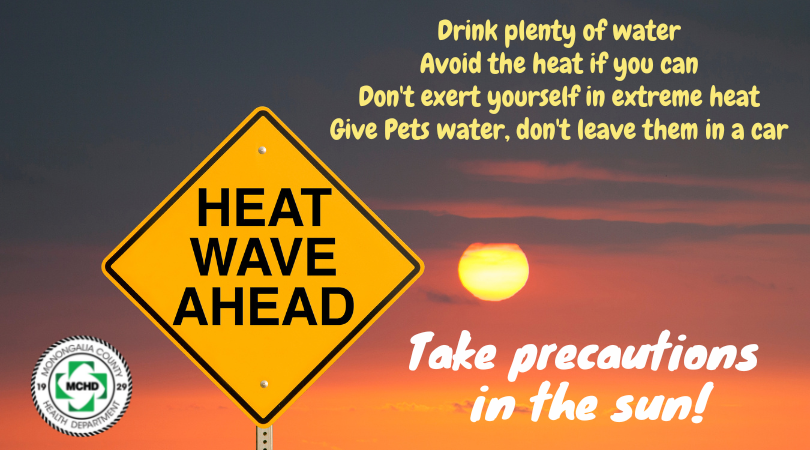Be careful. It's hot out there!

Jun. 15, 2022
By Mary Wade Burnside
A few years ago, I was involved in a litter cleanup project in my neighborhood. I ended up walking up and down an embankment on the rail-trail for an hour or so, picking up trash, in high heat and humidity.
Afterwards, I didn’t feel so great. I hated to admit it, but I was suffering from heat exhaustion. I had kept on going when I should have stopped. Having grown up in West Virginia’s hot and humid summers, I thought my tolerance was higher than what it really was.
We’ve already had some hot days as we head into summer, and today and tomorrow should be hitting the 90s, plus there are plenty of high temperatures in the extended forecast.
This is the time to take precautions for yourself and also any children or pets.
According to the Centers for Disease Control and Prevention, more than 600 people die each year in the United States from heat-related illnesses.
Heat stroke is the most severe condition that can result from spending too much time in the sun or a hot indoor space without proper cooling and ventilation.
The CDC’s breakdown of illnesses, symptoms and reactions are as follows:
- Heat stroke: High body temperature of 103 Fahrenheit or higher, hot, red, dry or damp skin; fast, strong pulse; headache; dizziness; nausea; confusion and losing consciousness. If you or someone around you experiences these symptoms, call 911 first and then move the person to a cooler place. Help lower the individual’s temperature with cool cloths or a cool bath. Do not give the person anything to drink.
- Heat exhaustion: Heavy sweating; cold, pale and clammy skin; fast, weak pulse; nausea or vomiting; muscle cramps; tiredness or weakness; dizziness; headache; fainting. In this instance, the individual should be moved to a cool place. Loosen their clothing. Cool the person down with wet cloths or a bath. Water can be sipped. Get medical help if symptoms include throwing up, if symptoms get worse or they last longer than one hour.
- Heat cramp: Heavy sweating during intense exercise; muscle pain or spasms. In this instance, stop the physical activity and move to a cool place. Drink water or a sports drink. Wait for cramps to go away before doing any more physical activity. Get medical help if cramps last longer than one hour, the person is on a low-sodium diet or has heart problems.
- Sunburn: Painful red and warm skins, can also include blisters on the skin. Avoid the sun until sunburn heals. Cool cloths or a cool bath can help. Use moisturizing or aloe lotion on the burns and don’t break the blisters.
- Heat rash: Red clusters of small blisters on the skin that look like pimples, usually on the neck, chest, groin and elbow creases. Stay in a cool, dry place and keep the rash dry.
Of course, the better option to all of these conditions is to take precautions. Avoid extreme heat when you can, and especially try to not exert yourself in it. According to Ready.gov, extreme heat is a period of high heat and humidity with temperatures above 90 degrees for at least two to three days.
But even on that first day, you want to be careful. Remain hydrated and take a bottle of water with you when you do go out. Don’t leave pets outside in the extreme heat, especially if there isn’t any shelter for them. Make sure they have plenty of water. If you are taking a dog for a walk, consider booties that will keep the pup’s paws off the hot pavement, or sticking to grassy areas (and making sure to check for ticks afterward).
Of course, as always, wear sunscreen. The American Academy of Dermatology recommends using sunscreen with an SPF of 30 or higher.
And remember, preparation is key year-round, and this stormy season that can bring on power outages is no exception.
There are steps you can take to make your home cooler during the summer. Ready.gov recommends covering windows with drapes and shades, weather-stripping doors and windows, using window reflectors specifically designed to reflect heat back outside and insulation to keep heat out.
Also consider making cooler meals that don’t require an oven, which would make your home even hotter.
Ready.gov also warns against relying on a fan as a primary cooling device because even though they create air flow and a false sense of comfort, they do not reduce body temperature or prevent heat-related illnesses.
If your home doesn’t have central air, install window air conditioners and insulate around them. A powered attic ventilator or fan also can help regulate the heat level of a building’s attic by clearing out hot air.
For those who cannot afford cooling costs, weatherization or energy-related home repairs, contact the Low Income Home Energy Assistance Program (LIHEAP) for help.
This is also a good time to remind everyone that having flashlights, batteries, accessible food and water and any other items to make members of a household comfortable during a power outage. Ready.gov offers advice on how to specifically deal with that situation and its aftermath.
It's always a good idea to never leave a pet in a car, even for just a few minutes.
But it is especially true in the heat, even when the temperatures are topping the 90s.
If necessary, spend time at a library or another air conditioned public place to help keep cool.
And once again, it can’t be stressed enough. Drink plenty of water, stay in a cool place as much as you can and be careful out there!
Mary Wade Burnside is the public information officer at Monongalia County Health Department.